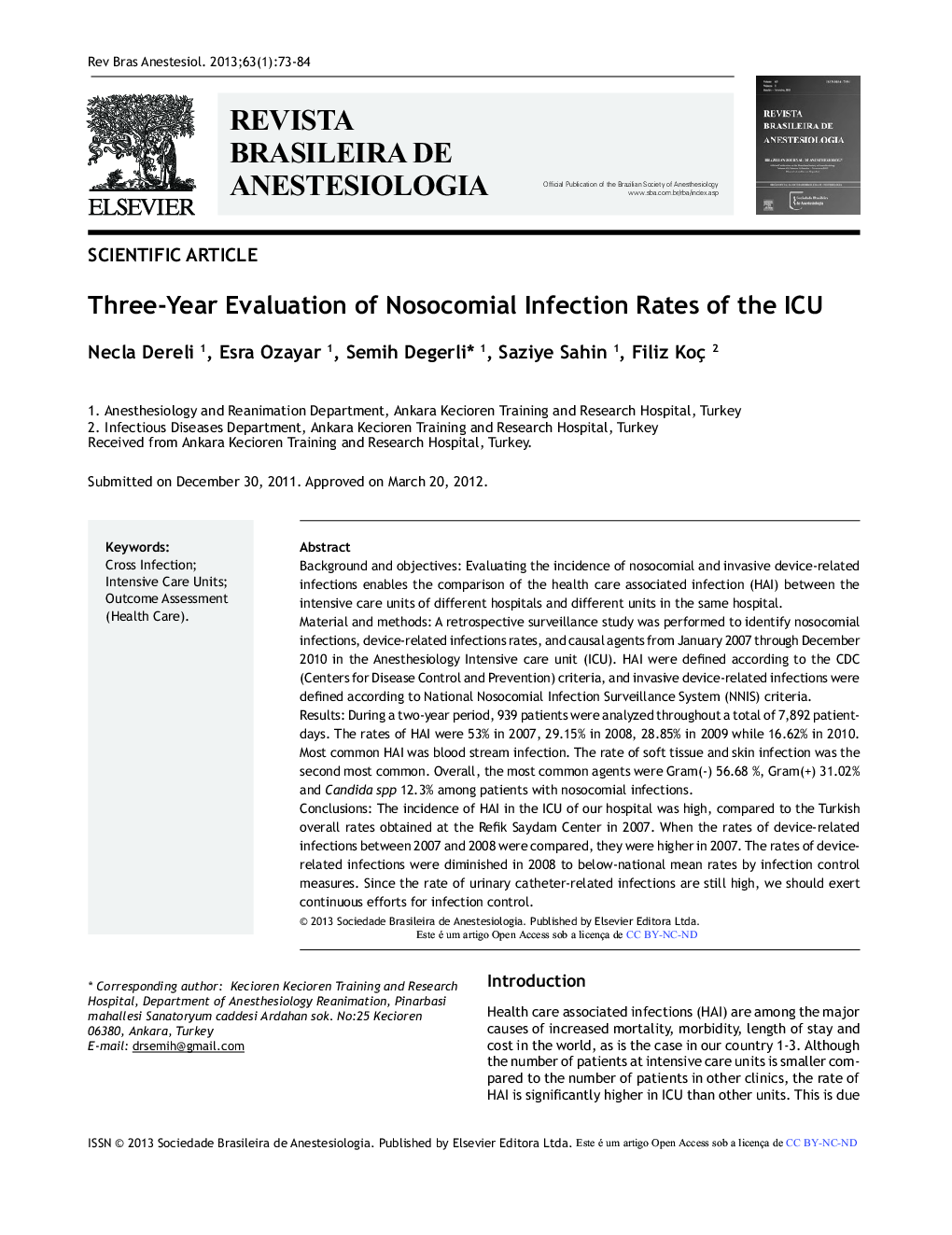| کد مقاله | کد نشریه | سال انتشار | مقاله انگلیسی | نسخه تمام متن |
|---|---|---|---|---|
| 2749414 | 1567244 | 2013 | 12 صفحه PDF | دانلود رایگان |

Background and objectivesEvaluating the incidence of nosocomial and invasive device-related infections enables the comparison of the health care associated infection (HAI) between the intensive care units of different hospitals and different units in the same hospital.Material and methodsA retrospective surveillance study was performed to identify nosocomial infections, device-related infections rates, and causal agents from January 2007 through December 2010 in the Anesthesiology Intensive care unit (ICU). HAI were defined according to the CDC (Centers for Disease Control and Prevention) criteria, and invasive device-related infections were defined according to National Nosocomial Infection Surveillance System (NNIS) criteria.ResultsDuring a two-year period, 939 patients were analyzed throughout a total of 7,892 patientdays. The rates of HAI were 53% in 2007, 29.15% in 2008, 28.85% in 2009 while 16.62% in 2010. Most common HAI was blood stream infection. The rate of soft tissue and skin infection was the second most common. Overall, the most common agents were Gram(−) 56.68%, Gram(+) 31.02% and Candida spp 12.3% among patients with nosocomial infections.ConclusionsThe incidence of HAI in the ICU of our hospital was high, compared to the Turkish overall rates obtained at the Refik Saydam Center in 2007. When the rates of device-related infections between 2007 and 2008 were compared, they were higher in 2007. The rates of devicerelated infections were diminished in 2008 to below-national mean rates by infection control measures. Since the rate of urinary catheter-related infections are still high, we should exert continuous efforts for infection control.
ResumoJustificativa e objetivosAvaliar a incidência de infecções nosocomiais associadas aos dispositivos invasivos permite comparar as infecções associadas aos cuidados em saúde (IACS) entre as unidades de terapia intensiva (UTI) de diferentes hospitais e unidades do mesmo hospital.Material e métodosDe janeiro de 2007 a dezembro de 2010, um estudo de vigilância retrospectivo foi realizado para identificar infecções nosocomiais, taxas de infecções relacionadas a dispositivos e agentes causadores na UTI de anestesiologia. As IACS foram definidas de acordo com os critérios do Centro de Controle e Prevenção de Doenças (CDC) e as infecções relacionadas aos dispositivos invasivos definidas de acordo com os critérios do Sistema Nacional de Vigilância de Infecções Nosocomiais (NNIS).ResultadosDurante dois anos, 939 pacientes em um universo de 7.892 pacientes/dia foram avaliados. As taxas de IACS foram de 53% em 2007, 29,15% em 2008, 28,85% em 2009 e 16,62% em 2010. A IACS mais comum foi infecção da corrente sanguínea. A taxa de infecção de tecido mole e pele foi a segunda. Entre os pacientes com infecções nosocomiais, os agentes causadores mais comuns foram Gram (−) 56,68%, Gram (+) 31,02% e candidíase 12,3%.ConclusõesA incidência de IACS na UTI de nosso hospital foi alta, em comparação com as taxas turcas globais obtidas no Refik Saydam Center em 2007. Quando as taxas de infecções relacionadas aos dispositivos foram comparadas entre 2007 e 2008, foram maiores em 2007. A taxas de infecções relacionadas aos dispositivos em 2008 foram reduzidas abaixo da média nacional por causa das medidas de controle de infecção. Como a taxa de infecções relacionada ao cateter urinário ainda permanece alta, devemos exercer esforços contínuos para o controle das infecções.
Journal: Brazilian Journal of Anesthesiology - Volume 63, Issue 1, January–February 2013, Pages 73-84